Introduction to Discog
The term ‘discog’ is a shortened form of ‘discography,’ which refers to a comprehensive list of recordings made by an artist, a band, or a record label. A discography provides vital information about music releases, including album titles, release dates, and track listings, serving as an essential tool for music lovers and researchers alike.
What is a Discography?
A discography documents all audio recordings attributed to a specific artist. It often includes various formats such as albums, singles, EPs, and even collaborative works. The information can range from studio albums to live recordings and remixes, making it an extensive catalog of an artist’s work.
Components of a Discography
A comprehensive discography typically contains several key elements:
- Album Title: The name of the album or the recording.
- Release Date: When the album was made available to the public.
- Label: The record label that produced the album.
- Track Listing: The list of songs included in the album.
- Credits: Information about the musicians, producers, and other contributors.
Why is Discography Important?
A well-documented discography is vital for several reasons:
- Research: It aids historians and musicologists in studying an artist’s evolution over time.
- Collectibility: Collectors use discographies to verify the authenticity and release details of albums.
- Streaming and Sales: Digital platforms like Spotify and Apple Music often reference discographies when cataloging artists’ work.
- Promotional Tool: Artists can use their discography to showcase their body of work to potential fans and industry professionals.
Case Study: The Beatles Discography
One of the most famous discographies is that of The Beatles, whose impact on music is still felt today. Their official discography includes:
- 12 studio albums, such as “Abbey Road” (1969) and “Sgt. Pepper’s Lonely Hearts Club Band” (1967).
- 13 EPs and over 50 singles, featuring iconic tracks like “Hey Jude” and “Let It Be”.
This extensive catalog showcases their musical evolution from simple pop tunes to complex experimental sounds, serving as a valuable reference for fans and scholars.
Statistics on Music Consumption and Discographies
With the rise of streaming services, the consumption of music has drastically changed. According to a report by the Recording Industry Association of America (RIAA) in 2022:
- Streaming accounted for over 83% of all recorded music revenue in the U.S.
- On average, listeners consume more than 30 hours of music per month, making access to an artist’s discography crucial for enjoying and exploring their work.
How to Create a Discography
Creating a discography can be an engaging project for any music enthusiast. Here are some steps to get started:
- Research: Start by gathering information on an artist’s complete body of work.
- Organize: Sort the entries by year, album title, or type of release.
- Verify: Ensure all details are accurate using reliable sources like music databases or the artist’s website.
- Present: Format the discography in an easily readable layout.
Conclusion
Discographies play a vital role in documenting the rich tapestry of an artist’s musical journey. Whether you are a casual listener, a dedicated fan, or a music researcher, understanding and utilizing discographies can deepen your appreciation of music. Next time you explore an artist’s work, take a moment to peruse their discography and discover the stories behind the songs.





